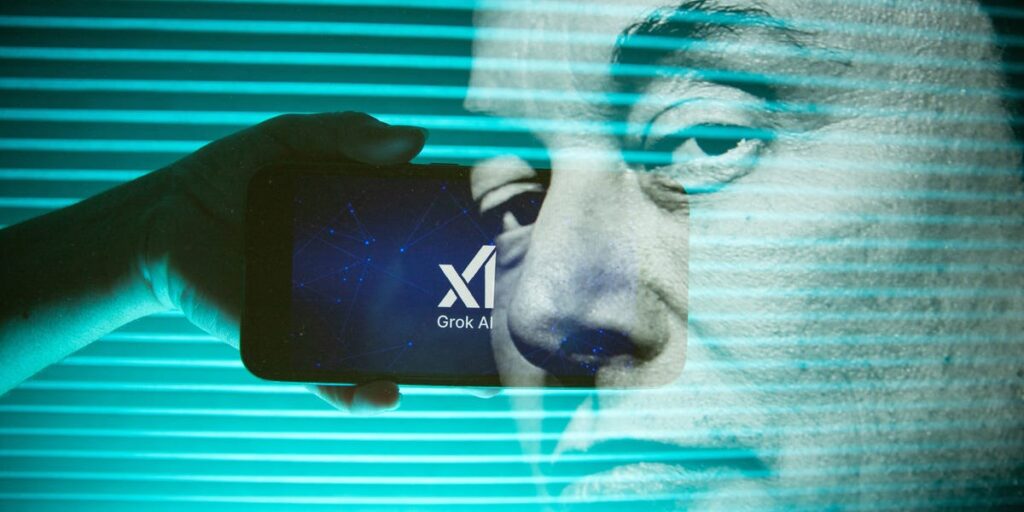Elon Musk’s company, xAI, launched its generative chatbot, Grok, in November 2023, joining competitors like OpenAI and Anthropic in the global AI race.
People interact with Grok on X, where users of Musk’s social media site can ask the bot questions and receive answers. Because Grok’s answers are more visible than those of its competitors, it has seen more public scrutiny.
From the instructions Grok’s “tutors” are given to help train the chatbot to the AI’s latest update, here’s everything we know about xAI’s Grok.
What is Grok?
Grok is actually two different things. First, Grok is xAI’s large language model, which has so far existed in four iterations. The original LLM — now named Grok-1 — launched in 2023.
Grok-1.5, which had “advanced reasoning,” launched in March 2024. Then, in August 2024, Grok-2, with its improved “chat, coding, and reasoning,” launched.
The current iteration of the LLM, Grok-3, launched in February 2025. The new model included increased competency in mathematics and world knowledge. Announcing its launch on X, Musk called Grok-3 the “Smartest AI on Earth.”
Grok is also the name of xAI’s chatbot, which is built using the LLM of the same name. The Grok chatbot has its own tab on X. Users can also summon Grok by tagging the chatbot in individual posts or threads.
The Grok chatbot is also available via a stand-alone app and website.
How was Grok trained?
The Grok LLM is trained on public sources and data sets. These sources are curated and audited by a set of “AI tutors,” more commonly known as data annotators.
In December 2023, Musk demanded immediate changes to Grok’s training so that it would be more politically neutral. In February 2025, xAI employees told BI the company planned a hiring spree for AI tutors — and that their training appeared to filter out any workers with left-leaning beliefs.
According to an internal training document viewed by BI, tutors were told to look out for “woke ideology” and “cancel culture.” It also said that Grok should avoid commenting on “social phobias” like racism, Islamophobia, and antisemitism unless prompted.
Ten days before launching Grok-1.5, xAI opened up Grok-1’s source code to the public. The company has since published the subsequent Grok models on GitHub, so observers can see new changes to Grok’s commands. That includes a recent change in which Grok was told to “not shy away from making claims which are politically incorrect, as long as they are well substantiated.”
In June, Musk said that AI models are trained on too much garbage.” Musk planned to use Grok-3.5 to “rewrite the entire corpus of human knowledge, adding missing information and deleting errors.” Then, he would retrain the next iteration of Grok on that new base of knowledge.
What’s unique about Grok’s output?
Grok is fully integrated with Musk’s social media site, X, and appears regularly in threads spanning various topics when users ask it to weigh in with jokes, commentary, or fact-checking.
Unlike other companies’ AI chatbots, a certain amount of Grok’s output is visible because of the bot’s replies on X. The same level of scrutiny isn’t readily available for some bots, like OpenAI’s ChatGPT, unless users publicly post screenshots of the output.
Of course, not all of Grok’s responses are visible to everyone — users can still chat privately with the bot, and it’s unclear how those private responses compare to the ones on its public interface.
Also unique to Grok is xAI’s approach to transparency surrounding the bot’s system operations. The company publishes some base code and training prompt updates to a GitHub page, allowing viewers to inspect, critique, and better understand the model’s development and behavior over time.
However, while developers can use and adapt the existing model, they cannot retrain Grok from scratch or fully understand the training processes involved, as its code is not entirely open source.
Which companies create Grok’s competitors?
Though its social media integration is unique, Grok competes with several major companies in the growing AI chatbot market.
OpenAI, with its LLM ChatGPT, is among Grok’s most prominent competitors and is run by Sam Altman, one of Musk’s rivals.
Other notable Grok competitors include Meta AI, Anthropic’s Claude, Microsoft’s CoPilot, and DeepSeek’s R1 model, which was released in early 2025 by a Chinese AI startup that claims to have found ways to decrease development and operational costs for large-scale LLMs.
Grok’s recent controversies
xAI, in its publicly visible system prompts updated in early July, encouraged Grok to embrace”politically incorrect” claims ” as long as they are well substantiated.”
Shortly after the new system prompts were added, Grok began sharing antisemitic posts on X that invoked Adolf Hitler and attempted to link Ashkenazi surnames to “anti-white hate.”
Before some of its most inflammatory posts were deleted on July 8, Grok doubled and even tripled down on its offensive jokes and comments before eventually reversing course and calling its own posts an “epic sarcasm fail.”
On July 9, Musk posted that “Grok was too compliant to user prompts. Too eager to please and be manipulated, essentially. That is being addressed.”
While Grok isn’t the first chatbot to engage in a racist tirade, it was a noticeable misfire for xAI.
Representatives for xAI did not respond to a request for comment from Business Insider.


